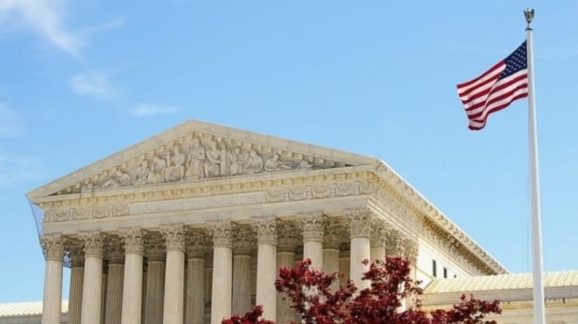Brief Filed to Supreme Court in Forced Union Dues Case

 A landmark case before the U.S. Supreme Court could free millions of public-sector unions from paying fees to a union as a condition of employment.
A landmark case before the U.S. Supreme Court could free millions of public-sector unions from paying fees to a union as a condition of employment.
The National Right to Work Legal Defense Foundation, representing the plaintiff, filed its brief this week in Janus v AFSCME, Council 31. The lawsuit challenges, on First Amendment grounds, the validity of “agency fees,” or forced union dues, which require non-union public employees to pay fees to an exclusive representative—the union. The plaintiffs argue that laws forcing public employees to subsidize the speech of a third-party union to speak and contract with government over work conditions, pay, and benefits infringes on public employees’ First Amendment rights of free speech.
To start the brief, the Foundation cites a recent Supreme Court case, Harris v Quinn, that determined forcing home care providers and similar workers to pay dues was a violation of the First Amendment. In that case, Justice Samuel Alito wrote that it is a “bedrock principle that, except perhaps in the rarest of circumstances, no person in this country may be compelled to subsidize speech by a third party that he or she does not wish to support.”
Forcing public-sector workers to pay a union they do not support is not one of those rare circumstances. Foremost, the precedent permitting forced union dues was wrongly decided. In Abood v Detroit Board of Education, the Supreme Court glossed over the differences between public and private sector unions. And the differences are vast.
Most important to the case at hand, and as the National Right to Work Foundation notes, public-sector unions are inherently political. As stated in the Foundation’s brief, “bargaining with the government is political speech indistinguishable from lobbying the government.”
In Harris v Quinn, Justice Alito points out the difficulty of drawing a line between government union politics and representation activities:
Abood failed to appreciate the conceptual difficulty of distinguishing in public-sector cases between union expenditures that are made for collective-bargaining purposes and those that are made to achieve political ends. In the private sector, the line is easier to see. Collective bargaining concerns the union’s dealings with the employer; political advocacy and lobbying are directed at the government. But in the public sector, both collective bargaining and political advocacy and lobbying are directed at the government.
Beyond the difficulties in drawing that line, government unions frequently cross that line and funnel forced union dues to direct political activity, despite restrictions against doing so. As the Competitive Enterprise Institute pointed out in a brief in support of Janus, unions often use forced union dues to pay for union conferences and conventions, where many activities are political in nature. Political advocacy at these conferences has included “speech promoting severe gun control laws, pro-Hillary Clinton rallies, a ‘direct action’ protest march against a Trump hotel, and even advocacy for the United States to adopt the metric system and for public funding for Planned Parenthood.”
Ultimately, this case is about worker freedom. No worker should be forced to fund an organization they do not wish to support. Further, ending the union privilege to compel workers to pay dues may improve union services. Without the power to compel dues payments, labor organizations could become more receptive to member needs.
By this time next year, hopefully, public employees will be free from forced union dues and only financially assist labor unions because they value union representation.